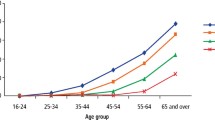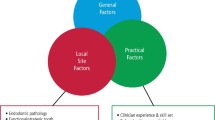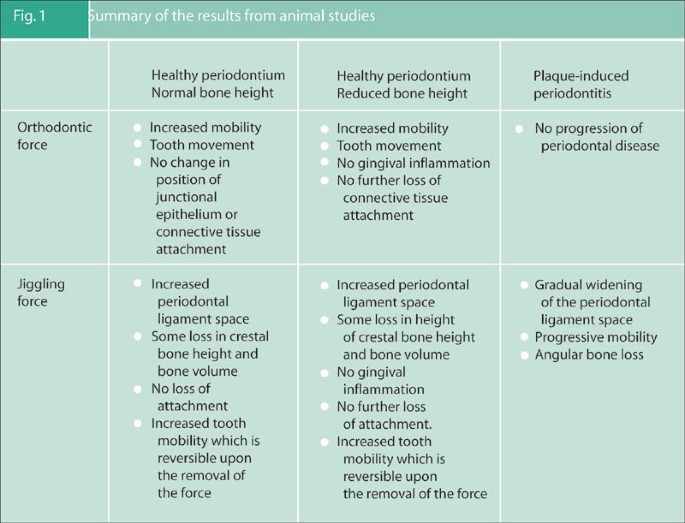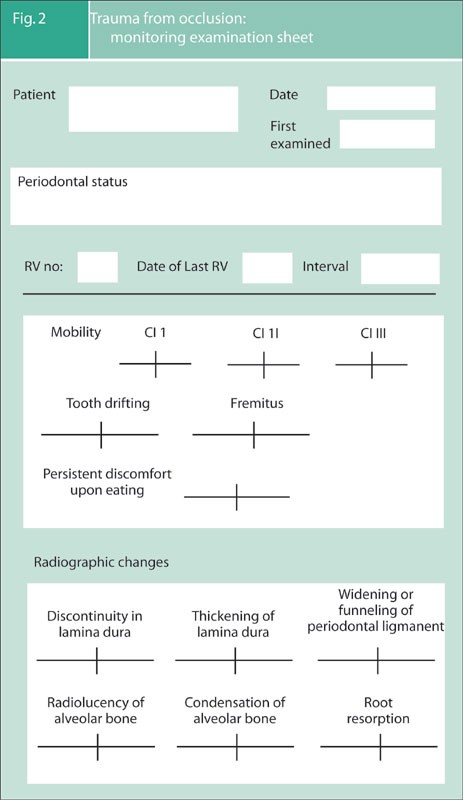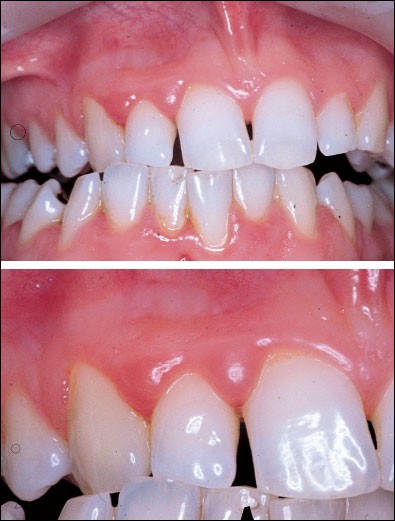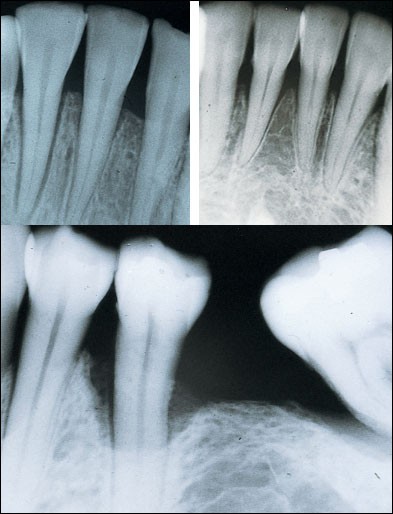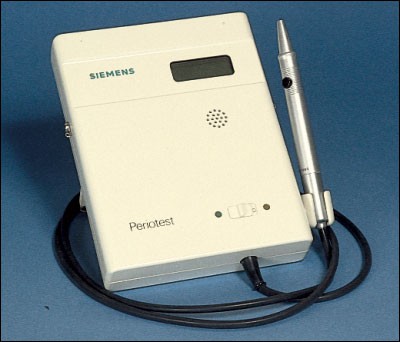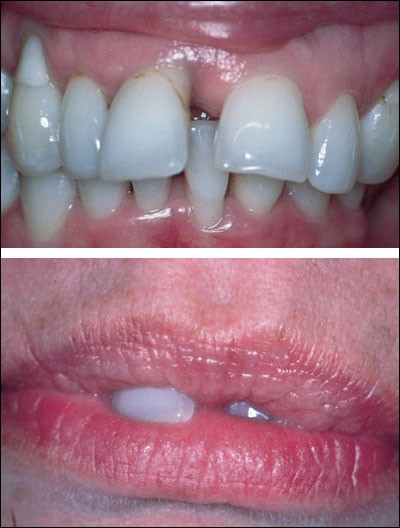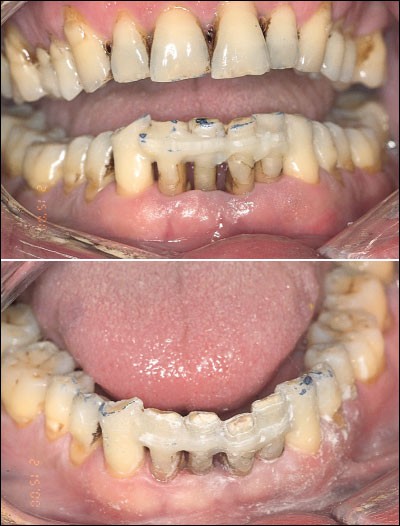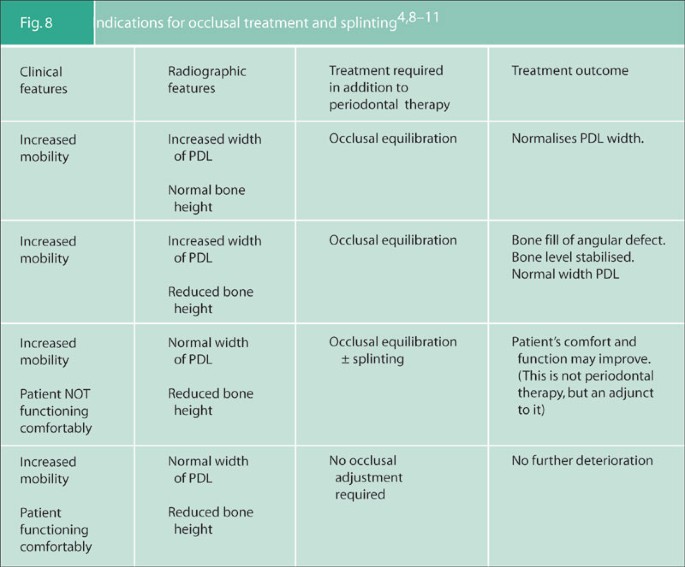Key Points
In this part, we will discuss:
-
Whether occlusal trauma is significant in the aetiology of periodontal disease
-
Whether occlusal treatment is indicated for patients suffering from periodontal disease
-
Making a diagnosis of trauma from occlusion
-
Tooth mobility
-
Occlusal equilibration and the splinting of teeth
Abstract
Periodontal disease does not directly affect the occluding surfaces of teeth, consequently some may find a section on periodontics a surprising inclusion. Trauma from the occlusion, however, has been linked with periodontal disease for many years. Karolyi published his pioneering paper, in 1901 'Beobachtungen uber Pyorrhoea alveolaris' (occlusal stress and 'alveolar pyorrhoea').1 However, despite extensive research over many decades, the role of occlusion in the aetiology and pathogenesis of inflammatory periodontitis is still not completely understood.
Similar content being viewed by others
Why should trauma from occlusion be considered to have a role in the aetiology of periodontal disease?
Occlusal trauma has been defined as 'injury to the periodontium resulting from occlusal forces which exceed the reparative capacity of the attachment apparatus': ie the tissue injury occurs because the periodontium is unable to cope with the increased stresses it experiences. Compare this definition with the one for inflammatory periodontal disease:
'Periodontitis is the result of an interaction between a susceptible host and bacterial factors in dental plaque, which exceeds the inherent protective mechanisms of the host'.
Both processes result in injury to the attachment apparatus because the periodontium is unable to cope with the pathological insult which it experiences. It is quite right, therefore, that dentists should ask themselves two questions:
-
1
Does occlusal trauma have a role in the aetiology of periodontal disease?
-
2
Should occlusal treatment be considered for the patient with compromised periodontal attachment?
Before attempting to answer these two questions, the different types of trauma from occlusion need to be defined.
How is trauma from occlusion classified?
Historically trauma from occlusion has been classified as either primary or secondary. Primary occlusal trauma results from excessive occlusal force applied to a tooth or to teeth with normal and healthy supporting tissues.
Secondary occlusal trauma refers to changes which occur when normal or abnormal occlusal forces are applied to the attachment apparatus of a tooth or teeth with inadequate or reduced supporting tissues. Recently, the distinction between primary and secondary occlusal trauma has been challenged as meaningless since the changes that occur in the periodontium are similar irrespective of the initial level of periodontal attachment. More usefully, occlusal trauma can also be described as acute or chronic.
Acute trauma from occlusion occurs following an abrupt increase in occlusal load such as occurs as a result of biting unexpectedly on a hard object. Chronic trauma from occlusion is more common and has greater clinical significance. In the context of this paper occlusal trauma will mean chronic occlusal trauma.
Question 1 Does occlusal trauma have a role in the aetiology of periodontal disease?
This is a key question because the answer will determine:
-
Whether occlusal forces influence the onset of plaque-induced inflammation.
-
Whether occlusal forces enhance the rate of periodontal destruction.
Considerable energy has been directed at trying to determine the answer to these questions, because of the possibility that trauma from occlusion might contribute to the pathogenesis of periodontal disease. Research studies designed to examine the effects of occlusion fall into three categories:
-
Human cadaver investigations
-
Animal studies
-
Human clinical studies.
1. Human cadaver investigations
Studies published in the 1960s and 1970s were inconclusive.2,3
2. Animal studies
In these studies the variables were the level of periodontal attachment and the characteristics of an applied force, and the way in which it might be varied (See Figure 1 for a summary of the results).
The periodontal attachment level is one of three types:
-
A normal healthy periodontal support
-
A healthy periodontal support but a reduced bone height. This is the experimental model equivalent of a post-periodontal therapy level
-
An active plaque-induced periodontitis.
The type of force that can be applied to the animal tooth is:
-
Either a jiggling force, which is produced by multi-directional displacement of a tooth in alternating buccolingual or mesiodistal directions. This is usually created in the animal by the provision of a supraoccluding onlay.
-
Or is an orthodontic force, created by a spring and is a unilateral force that results in the deflection of the tooth away from the force.
3. Human clinical studies
Few clinical studies have identified a clear relationship between trauma from the occlusion and inflammatory periodontitis in humans. A major problem with clinical studies of this type is the lack of a reliable index for measuring the degree of occlusal trauma to which a tooth is subjected.
If trauma from occlusion exists there are obvious difficulties in assessing whether the rate of attachment loss is greater in patients with a continuing plaque induced periodontitis. This is because secondary referral units where the majority of clinically based studies are carried out, do not routinely monitor patients who maintain good plaque control.
On the system level ideal occlusion is or is not ideal for the rest of the articulatory system: the temporomandibular joints and the masticatory muscles. It has, however, been stressed that there is no such thing as an intrinsically bad occlusal contact, because the effect is a product of not only the'quality' of the contact or contacts but also the frequency at which the contact or contacts are made. Also, it is widely accepted that some patients, at some times will have an articulatory system which is compromised by other factors which reduce their tolerance to a less than ideal occlusion. Factors may range from a systemic disease such as rheumatoid arthritis to the debilitating effects of chronic long term stress.
On the tooth level an occlusion may or may not be ideal for the attachment apparatus, and the same consideration must be given to the frequency of occlusal contact, ie Does parafunction occur? In addition, the ability of the attachment apparatus to withstand a less than ideal occlusion may be compromised by periodontal inflammation.
This leads to the second question:
Question 2 Should occlusal treatment be considered for the patient with compromised periodontal attachment?
If it is accepted that increased occlusal forces could result in a further loss of attachment for teeth with an active inflammatory periodontitis, then it follows that a treatment plan aimed at preserving these teeth must address both problems. This does not mean that trauma from occlusion causes periodontitis; rather, it means that occlusal forces may exceed the 'resistance threshold' of a compromised attachment apparatus thereby exacerbating a pre-existing periodontal lesion. While we know that trauma from occlusion can have an effect on the supporting tissues of the teeth, there is no evidence, at present, that trauma from occlusion is an aetiological factor in human periodontal disease.
It follows, therefore, that even though occlusal trauma is not a proven aetiological factor in periodontal disease dentists as part of their responsibility to help patients keep their teeth for as long as possible in maximum health, comfort and function must carry out a thorough occlusal examination. Treatment aimed at reducing occlusal forces so that they fall within the adaptive capabilities of each patient's dental attachment apparatus will benefit; particularly those with, or at future risk, of periodontitis.
Technique
Examination:
Clinical diagnosis of trauma from occlusion
Increased tooth mobility is not always indicative of trauma from occlusion. It is important, however, that hypermobility which does occur as a result of trauma from occlusion is detected in patients with reduced periodontal attachment. The reason for this is that trauma from occlusion may accelerate further reduction in attachment in a patient with active periodontitis.
A clinical diagnosis of occlusal trauma can only be confirmed where progressive mobility can be identified through a series of repeated measurements over an extended period. This means that simple but reliable monitoring needs to be undertaken. A simple monitoring protocol is needed (Fig. 2).
The common clinical signs of occlusal trauma are:
-
Increasing tooth mobility and migration or drifting (Fig. 3)
-
Fremitus
-
Persistent discomfort on eating.
The common radiographic signs of occlusal trauma are (Fig. 4):
-
Discontinuity and thickening of lamina dura
-
Widening of periodontal ligament space ('funnelling or saucerisation')
-
Radiolucency and condensation of alveolar bone/or root resorption.
Tooth mobility
Conventional methods for measuring tooth mobility are based on the application of a force to the crown of the tooth to assess the degree of tooth movement in the horizontal and vertical directions. Pathological mobility is defined as horizontal or vertical displacement of the tooth beyond its physiological boundaries. Normal physiological movement is thought to vary between 10 μm and 150 μm and would not be detectable on clinical examination. Clinically detectable mobility indicates some change in the periodontal tissues (ie it is pathological) and the cause of the mobility needs to be diagnosed.
Tooth mobility can be recorded using Miller's Index:
-
I
— up to 1 mm of movement in a horizontal direction
-
II
— greater than 1 mm of movement in a horizontal direction
-
III
— excessive horizontal movement and vertical movement.
How can tooth mobility be measured?
Manual evaluation
Manual evaluation of mobility is best carried out clinically using the handles of two instruments to move the teeth buccally and lingually.
Fremitus
Fremitus is the movement of a tooth or teeth subjected to functional occlusal forces, this can be assessed by palpating the buccal aspect of several teeth as the patient taps up and down.
Periodontometers
A periodontometer was a research tool used in the 1950s and 1960s to standardise the measurement of even minor tooth displacement. To date, this instrument has been used in a few clinical studies and has limited practical use.
Periotest ®
This device (Fig. 5) was produced in Germany in the late 1980s to provide a more reliable method for determining tooth mobility. It is designed to measure the reaction of the periodontium to a defined percussion, delivered by a tapping instrument. Again this is of limited use in general dental practice.
Tooth drifting or migration
Independent of the state of the supporting tissues of a tooth, if it has moved its position in the mouth, then some force has been responsible for pushing or pulling it. Clearly that force may be extrinsic such as can be seen in pipe smokers or in pencil chewers. Secondarily a soft tissue force may be responsible as with tongue thrusting or lip position (Fig. 6). However, the force may be from an occlusal contact especially parafunction. A frequently encountered scenario is drifting of an upper lateral incisor. This is a common reason for referral of an adult patient to an orthodontist; a referral made usually at the patient's request, with the aim of restoring their appearance. It is important to discover the cause of the drifting before considering any treatment.
Discomfort upon eating
It is important to evaluate how tooth mobility affects the patient. If there is discomfort when eating this will have a direct influence upon treatment. The decision will need to be taken, in consultation with the patient, whether to accept the discomfort, extract or splint.
Treatment
(Occlusal considerations in the treatment of periodontitis)
Equilibration

Occlusal equilibration is the modification of the occlusal contacts of teeth to produce a more ideal occlusion.
Is there a need for occlusal equilibration in the periodontally compromised dentition?
The literature does not give an answer to this question. Some studies have shown occlusal therapy to be beneficial in the management of periodontal disease, whilst others have failed to do so.7,8,9 Burgett et al. reported that occlusal adjustment to reduce tooth mobility before conventional periodontal treatment, leads to probing attachment gain after such therapy.7 The current dental literature, however, suggests that if occlusal adjustment is required it should be carried out after periodontal treatment.
There is no evidence at the present time to suggest that occlusal equilibration is an appropriate method for preventing the progression of periodontitis. It would, however, be useful to know whether equilibration of a periodontally compromised dentition is beneficial for the long-term preservation and comfort of teeth, in those patients who fail to achieve an excellent level of plaque control.
Equilibrating mobile teeth
In a patient with mobile teeth, it may be necessary to temporarily stabilise those teeth before equilibration is possible (Fig. 7a,b). If a tooth is mobile, it is very difficult if not impossible to effectively modify its shape with the aim of reducing the occlusal forces acting upon it (equilibration).
When to equilibrate ( Fig. 8 )
Whether occlusal equilibration is indicated will depend upon:
-
Whether the inflammatory periodontitis has been treated successfully. If there is an inflammatory periodontal process this should be treated initially. Subsequently when the periodontal condition is stable, occlusal therapy may be necessary for some patients and could involve either occlusal equilibration or splinting.
-
The radiographic appearance of the periodontal support. Occlusal equilibration is considered an effective form of therapy for teeth with increased mobility which has developed together with an increase in the width of the periodontal ligament (PDL). Reducing the occlusal interference on a tooth with normal bone support will normalise the width and height of the PDL. Eliminating any occlusal interferences for a tooth which has a reduced bone height as a result of periodontal disease will result in bone formation and remodelling of the alveolus only to the pre-trauma level.
In contrast, if the hypermobile tooth has reduced bone height but normal periodontal ligament width, then elimination of occlusal trauma will not alter the mobility of the tooth. In this situation occlusal equilibration is only indicated if the patient is complaining of loss of function or discomfort.
Occlusal therapy in a periodontal treatment plan is established practice
'The World Workshop of the American Academy of Periodontology',13 issued some guidelines for situations when occlusal equilibration may be indicated:
-
When there are occlusal contact relationships that cause trauma to the periodontium, joints, muscles or soft tissues
-
When there are interferences that aggravate parafunction
-
As an aid to splint therapy.
Splinting
When should teeth be splinted together in the patient with reduced periodontal support? (Fig. 8)
Also outlined13 were some indications for splinting, not only restricted to patients with reduced periodontal support:
-
To stabilise teeth with increased mobility that have not responded to occlusal adjustment and periodontal treatment
-
To prevent tipping or drifting of teeth and the overeruption of unopposed teeth
-
To stabilise teeth after orthodontic treatment
-
To stabilise teeth following acute trauma.
The first guideline refers to patients with reduced periodontal support. There are two situations in which splinting may be beneficial:
-
Where tooth mobility is progressive with increased periodontal ligament width and reduced bone height then splinting is indicated as part of periodontal therapy.
-
When patient comfort and function will be improved by splinting, then it is indicated, as an adjunct to periodontal therapy.
This means that if periodontal treatment results in a stable periodontal condition which is comfortable, splinting is not needed.
Summary: Trauma from occlusion in the aetiology and treatment of periodontal disease
-
There is no scientific evidence to show that trauma from occlusion causes gingivitis or periodontitis or accelerates the progression of gingivitis to periodontitis.
-
The periodontal ligament physiologically adapts to increased occlusal loading by resorption of the alveolar crestal bone resulting in increased tooth mobility. This is occlusal trauma and is reversible if the occlusal force is reduced.
-
Occlusal trauma may be a co-factor which can increase the rate of progression of an existing periodontal disease.
-
There is a place for occlusal therapy in the management of periodontitis, especially when related to the patient's comfort and function.
-
Occlusal therapy is not a substitute for conventional methods of resolving plaque-induced inflammation.
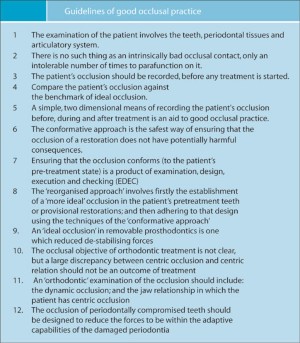
References
Karolyi M . Beobachtungen uber Pyorrhoea alveolaris. Ost-Unt Vjschr Zahnheilk 1901; 17: 279.
Glickman I, Smulow J B . Alteration in the pathway of gingival inflammation into the underlying tissues induced by excessive occlusal forces. J Periodontol 1962; 33: 8–13.
Waerhaug J . The infrabony pocket and its relationship to trauma from occlusion and subgingival plaque. J Periodontol 1979; 50: 355–365.
Green M S, Levine D F . Occlusion and the periodontium: A review and rationale for treatment. J Calif Dent Assoc 1996; 24: 19–27.
Jin L J, Cao C F . Clinical diagnosis of trauma from occlusion and its relation with severity of periodontitis. J Clin Perio 1992; 19: 92–97.
Philstrom B L, Anderson K A, Aeppli D, Shafter E M . Association between signs of trauma from occlusion and periodontitis. J Periodontol 1986; 57: 1–6.
Burgett F G, Ramford S T, Nissle RR, Morrison E C, Charbeneau T D, Caffesse R G . A randomised trial of occlusal adjustment in the treatment of periodontitis patients. J Clin Periodontol 1992; 19: 381–388.
Galler C, Selipsky H, Philips C, Amnons W F Jr . The effects of splinting on tooth mobility. II. After osseous surgery. J Clin Periodontol 1979; 6: 317–333.
Linde J, Nyman S . Clinical Periodontology and Implant Dentistry. 3rd Ed. Ch 23: Occlusal Therapy pp711–726 Copenhagen: Munksgaard, 1997.
Svanberg G K, King G T, Gibbs C H . Occlusal considerations in periodontology. Periodontol 2000 1995; 9: 106–117.
Walton G, Heasman P . The role of occlusion in periodontal disease. Dent Update 1998; 25: 209–216.
Polson A M, Zander H A . The effect of periodontal trauma upon infrabony pockets. J Periodontol 1983; 54: 586–592.
Proceedings of the World Workshop in Clinical Periodontics. Chicago. Consensus report: Occlusal Trauma. The American Academy of Periodontology 1989: III-1/III-23.
Author information
Authors and Affiliations
Corresponding author
Additional information
Refereed Paper
Rights and permissions
About this article
Cite this article
Davies, S., Gray, R., Linden, G. et al. Occlusal considerations in periodontics. Br Dent J 191, 597–604 (2001). https://doi.org/10.1038/sj.bdj.4801245
Published:
Issue Date:
DOI: https://doi.org/10.1038/sj.bdj.4801245
This article is cited by
-
Factors affecting decision making at reassessment of periodontitis. Part 1: history and examination at reassessment
British Dental Journal (2019)
-
Experience with bruxism in the everyday oral implantology practice in the Netherlands: a qualitative study
BDJ Open (2018)
-
Interplay of occlusal forces and the periodontium
international journal of stomatology & occlusion medicine (2016)
-
The remodeling of alveolar bone supporting the mandibular first molar with different levels of periodontal attachment
Medical & Biological Engineering & Computing (2013)
-
The interdisciplinary management of patients with amelogenesis imperfecta – restorative dentistry
British Dental Journal (2012)


